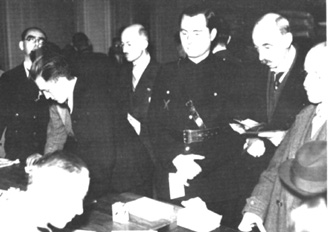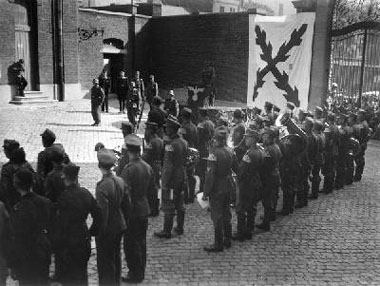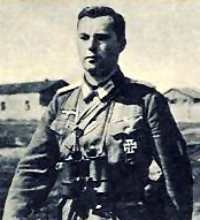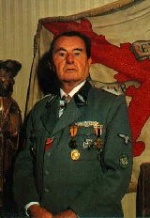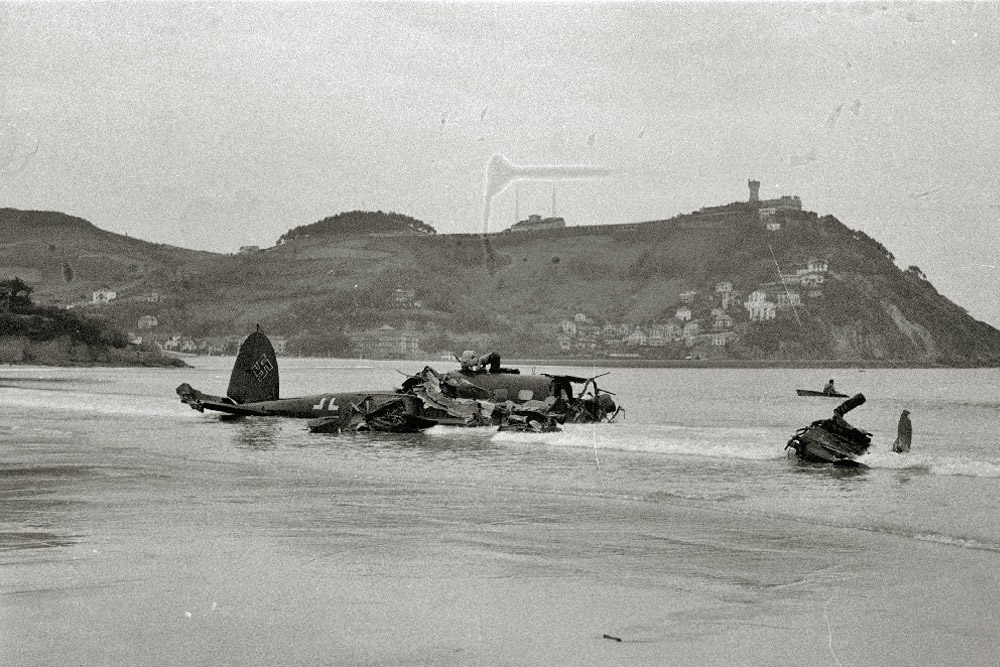The early years
Léon Degrelle was born June 15th 1906, in Bouillon in the province of Luxemburg near the Belgian-French border. Between 1920 and 1924, he attended secondary school at the Jesuit college Notre Dame de la Paix (Our Sacred Lady of Peace) in Namur and went on to study law at the University of Louvain. He became editor of the student's magazine 'l'Avant Garde' and deemed this so important that he neglected his studies. He became the leader of the 'Association des Etudiants Catholiques à l'Université de Louvain' (Association of Catholic Students at Louvain University) and later on became involved in the 'Association de la Jeunesse Catholique Belge' (Association of Belgian Catholic Youth). In March 1929 he became the editor of the 'Cahiers de la Jeunesse Catholique', (Organ of Catholic Youth) the official paper of the movement.
At the end of October 1930, his mentor asked him to become editor-in-chief of the publishing firm Editions Rex, which published flyers by the name of Christ Rex for the Action Catholique (Catholic Movement). In that capacity he drew the attention of the Catholic Party which was looking for someone to handle their propaganda. Through his publishing firm, Degrelle got heavily involved in the 1932 elections, much to the disgust of the apolitical A.J.C.B. The papers he published, including Vlan, Soiree and Rex caused a lot of consternation among Catholics for their violent polemics on politics and political programs. In 1933, the A.J.C.B. set Degrelle an ultimatum but a final break with the Catholic Party did not occur until 1936.
Rex as a political movement was established on November 2nd, 1935, and initially enjoyed quite a following, because of Degrelle's eloquence and his attacks on socialism and capitalism. The elections on May 24th, 1936, resulting in 10 seats in parliament for the party were successful but afterwards, support for the party waned quickly. The party did not have a clear political program, hence had little to offer to its electorate and as a result, the elections of November 11th, 1937, ended in disaster and those of April 2nd, 1939, even meant the end of Rex as a political movement, also ending Degrelle's career as a politician.
After the German occupation in 1940, Rex declared its solidarity with the Nazis and consequently, Degrelle was arrested along with some others for his pro-German activities. He was deported to France where he was kept imprisoned at Abbéville and subsequently in Vernet, close to the Spanish border. He was liberated on July 22nd, 1940 and returned to Belgium. Once there he tried to rekindle his political activities but without any real success.
Definitielijst
- propaganda
- Often misleading information used to gain support among supporters or to gain support. Often used to accomplish ideas and political goals.
- socialism
- Political ideology aiming at slight or no class differences. Means of production are owned by the state. Evolved as a response to capitalism. Karl Marx tried to substantiate socialism scientific.
Images
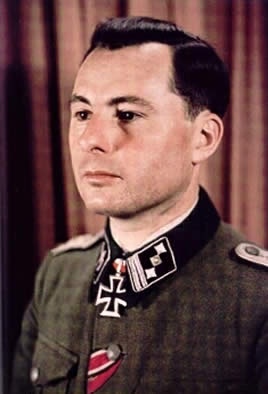 Léon Degrelle, leader of the Wallonian collaboration movement. Source: TracesOfWar.
Léon Degrelle, leader of the Wallonian collaboration movement. Source: TracesOfWar.The Wallonian Legion and the legion in the Wehrmacht
February 1941, the Wehrmacht authorities in Belgium had decided to enlist local troops in the NSKK (National-Socialist Driver Korps) and Degrelle immediately offered his services in the form of the Brigade Motorisée Rexiste (Motorized Brigade Rex) and promised to deliver 1,000 men for the NSKK. He ultimately delivered only 300. Degrelle saw military collaboration as the only means to gain sympathy with the Germans and he eagerly awaited a chance for more.
On June 22nd, 1941, Hitler invaded the Soviet Union and that was what Degrelle had been waiting for. Earlier that year, Rex received permission from Berlin to establish the Wallonian Legion (Légion Wallonie), consisting of French-speaking Belgians, anti-Communists and other adventurers. Wanting to set an example for others, Degrelle himself joined on July 20th, 1941. His request to be promoted to Lieutenant, a rank more in keeping with his political status, was denied since he had no military experience whatsoever. The Legion was incorporated into the Wehrmacht and left for the Eastern front on August 8th, 1941. Its members had been assured to be back with their families before the year was out after having served in rearguard duties only.
In early 1942, news arrived to the effect that between mid-February and the end of March, the Legion had been involved in fierce front line battles around Gromowaja-Balka and had suffered heavily in the process. The mere existence of the Legion was endangered and subsequently, a second contingent left for the East on March 10th, 1942. Moreover, on September 17th, 1942, in Schadyschenskaja, Degrelle had met General Felix Steiner and had understood immediately that in the long run, it would be more advantageous for Rex to disengage itself from the reactionary Wehrmacht and join the more dynamic, revolutionary-minded Waffen-SS, which in the end would possess all the power. According to Degrelle, enrollment in the Waffen-SS, the members of the Legion were, after all, Belgians, would pose no problem because, as he said: 'Wallonians are a Germanic people that happen to speak French.'
The Wallonian volunteers were placed in 4 companies of 'Wallonian Infantry Battalion 373' and on August 8th, they left for basic military training at the Regenwurmlager in Meseritz near the Polish border. Degrelle started his military career as a private with 1 Group, 1 Platoon of 1 Company and in October 1941, they left for the Eastern front. On December 10th, the Legion was incorporated into the 101. Jäger-Division and deployed in the Samara region to eliminate Soviet units that had been left behind. On January 15th, 1942, Degrelle sustained his first war injury near Nikolewskaja having been run over by a laden munitions sled.
On January 18th, 1942, Marshall Timosjenko launched a massive assault against the junction between 6. and 17. Army and a breakthrough was imminent. On January 26th, the Legion, along with Croatian units was ordered to push through to the river Samara and on February, 18th, under withering Soviet artillery fire, they managed to occupy the village of Gromowaja-Balka. On February 28th, a fierce assault by tanks and infantry was launched against the positions of the Legion. After heavy fighting, these were taken by the Soviets but subsequently retaken by the Legion. This battle action, the first by the Legion was important enough to be mentioned in dispatches of 100. Infanterie-Division. Degrelle, promoted to Gefreiter on February 11th, was promoted again on the spot to Feldwebel for his courageous actions and awarded the Iron Cross Second Class by General Sanne on March 2nd, 1942. In a parade on March 13th, a further 35 members of the Legion were awarded the Iron Cross Second Class but the price had been high: losses had been so severe that 2. Company had to be disbanded, only 12 men remained.
May 1st, 1942, Degrelle was promoted to Leutnant and on May 5th, the Legion was joined to the 97 Jäger Division and would stay with this unit until after the campaign in the Caucasus in November 1942. On May 9th, Marshall Timosjenko launched an attack, threatening to break through the front line of 6. Army again. At the same time, Marshall Koniev and his tank army broke through to the railway junction at Merefa south of Charkow. The German positions were in danger and a counter-attack was launched. The Wallonian Legion advanced out of Alexandrowka in order to relieve 101. Jäger-Division near Nowo-Jablenskaja. After heavy fighting, the Soviets were driven from their positions; a Panzergrenadier group occupied the village of Jablenskaja and the Legion cleared the village of Nikolajevka. For these engagements, Degrelle was awarded the Iron Cross First Class on May 21st, 1942, while a further 12 Wallonians were awarded the Iron Cross Second Class.
Because of the heavy losses suffered at Gromowaja, re-enforcements were desperately needed and so, on March 10th, a second contingent of Wallonians left Brussels for the Regenwurmlager. Meanwhile, 1st, 3rd, and 4th, companies relieved a German battalion in Spaschowska on the river Donetz. In mid-June, 1. Panzerarmee launched a preliminary attack in order to gain a better jumping off point for the coming summer offensive. The objective was to capture the last remaining Soviet bridgehead near Isjum. The operation was difficult for the Soviets were solidly entrenched on both river banks; a wide flanking movement was the only possibility. After a heavy artillery barrage on June 24th, the Legion launched its attack and took up positions near the village of Kamenka. They crossed the river and advanced through the woods to the railway line between Kransnyi and Isjum and in the afternoon linked up with units of 97. Infanterie-Division. With that, their mission had been accomplished without too many losses and on June 25th, they were pulled back to Brachowka. On July 4th, General Ruppe inspected the unit, presenting the Iron Cross Second Class to a number of Wallonians.
Meanwhile, Hitler had been drawing up plans for a massive campaign in the Caucasus to capture, among other things, the oil fields and so, the Legion left Shurki on July 7th, and reached Maikop after completing a forced march of 500 miles in 38 days; due to illness and exhaustion, only 500 men were still fit. On August 26th, from the village of Tserjakov, a patrol was dispatched to clear out a Soviet mortar nest that had already caused numerous victims. 1st, and 3rd, companies combed the hills and managed to eliminate the enemy. Following the fighting, Degrelle was awarded the Allgemeine Sturmabzeichen (General Assault Badge) by General Ernst Ruppe, commander of 97. Jäger-Division; a further 11 men were awarded the Iron Cross Second Class. The skirmishes continued up to September 2nd, when the Legion was relieved by two motorized companies of 5. SS-Panzer-Division "Wiking". In September and October, the Wallonians advanced along the river Psisch towards Touapse but they would never reach it for on November 11th, 1942, they were withdrawn from the front line. 180 men of the first contingent were sent on leave, the remainder was evacuated to the Crimea in February 1943. In special recognition of their outstanding achievements, the Wallonian Caucasus veterans were granted the privilege to wear the Gebirgsjäger-Abzeichen (Badge of the mountain troops), an Edelweiss.
Definitielijst
- Brigade
- Consisted mostly of two or more regiments. Could operate independently or as part of a division. Sometimes they were part of a corps instead of a division. In theory a brigade consisted of 5,000 to 7,000 men.
- collaboration
- Cooperation of the people with the occupying forces, more generally spoken the term for individuals who cooperate with the occupying force is collaborator.
- Infantry
- Foot soldiers of a given army.
- Iron Cross
- English translation of the German decoration Eisernes Kreuz.
- Jäger
- Also called fighter plane. Fighter planes can be used for air defence (armed with guns and/or carrying guided missiles) or for tactical purposes (armed with nuclear or conventional bombs or rockets). The aircraft used for tactical purposes are also called fighter- bombers because they are bombers with the speed and manoeuvrability of a fighter. Tactical fighters, equipped with photographic equipment are also used as reconnaissance plane.
- mid
- Military intelligence service.
- mortar
- Canon that is able to fire its grenades, in a very curved trajectory at short range.
- offensive
- Attack on a smaller or larger scale.
- Soviet Union
- Soviet Russia, alternative name for the USSR.
- Waffen-SS
- Name of Military section of the SS.
- Wehrmacht
- German armed military forces, divided in ground forces, air force and navy.
Images
The Legion in the Waffen-SS
On May 24th, 1943, in Pieske barracks near Meseritz, the Legion was inspected by Reichsführer-SS Heinrich Himmler who announced that the Legion was to be incorporated into the Waffen-SS from June 1943 onwards and was to be renamed SS-Sturmbrigade Wallonien. From June to October the Legion completed advanced military training at Wildflecken and then left for the East.
In the fall of 1943, on the river Dnjepr, the situation had become precarious for the German Army. The Red Army advanced from all sides and threatened Uman in the Ukraine with the Germans desperately trying to hold on to their positions. One of those was Cherkassy, an industrial area, some 100 miles downriver from Kiev; an unprotected but fiercely defended salient some 15 miles deep. Defense was the responsibility of 5. SS-Panzer-Division "Wiking", commanded by SS-Gruppenführer Herbert-Otto Gille and on November 20th, the Legion joined this unit as a tactical reserve. During December, numerous attacks were launched across the river Olschanka and on January 4th, two Wallonien assault groups had successfully executed a pincer movement near Sakrewka. Meanwhile, two Soviet regiments had captured the Teklino forest. German counter-attacks were repulsed at heavy cost and Degrelle, who had risen to SS-Obersturmführer suggested four companies of the Brigade be deployed. After three days of savage fighting they succeeded in recapturing the forest but once they had been relieved, the ground was lost again.
On January 20th, the Germans on the Dnjepr found themselves completely trapped and the Wallonians were ordered to cover a breakout by holding the village of Nova-Buda at all costs. Degrelle, who had been promoted to SS-Hauptsturmführer in the meantime was injured and was evacuated. He was awarded the Nahkampfspange in Silber (Close Combat Clasp in Silver) and the Verwundetenabzeichen in Gold (Wound Badge in Gold).
The Brigade was the last unit to retreat from the area. In recognition of their courageous actions, they were mentioned in a Wehrmacht dispatch; Degrelle was awarded the Ritterkreuz (Knight's Cross) for his participation. Of the 1850 men who participated in the Cherkassy campaign, only 632 remained. In March 1944, a number of them returned to Belgium and held a victory parade in Charleroi on April 1st and the next day in Brussels.
Definitielijst
- Brigade
- Consisted mostly of two or more regiments. Could operate independently or as part of a division. Sometimes they were part of a corps instead of a division. In theory a brigade consisted of 5,000 to 7,000 men.
- Red Army
- Army of the Soviet Union.
- Waffen-SS
- Name of Military section of the SS.
- Wehrmacht
- German armed military forces, divided in ground forces, air force and navy.
Images
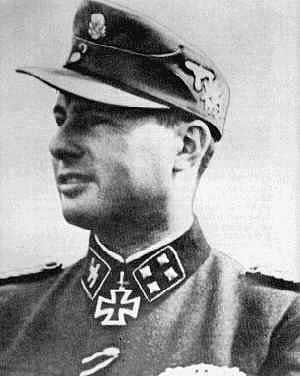 Degrelle takes a leading role in the SS-Sturmbrigade Wallonien. Source: Wikipedia.
Degrelle takes a leading role in the SS-Sturmbrigade Wallonien. Source: Wikipedia.The final months
In the summer of 1944, at the end of the Cherkassy campaign, a battalion of Wallonians was dispatched to Estonia in support of the local troops. On July 20th, 452 officers and men arrived in Voka training barracks, 30 miles west of Narwa. They were inspected by SS-Obergruppenführer Felix Steiner nine days later. Degrelle, who had attended his brother's funeral who had been murdered by the Belgian resistance on July 14th, arrived as late as August 8th. He left two days later with the 2nd and 4th companies for Maarja-Magdaleine, north of Dorpat, in support of Kampfgruppe Wagner holding a number of fortifications along a line 20 miles long front from Elva and Lüva to Patska south of Dorpat. On the August 19th, the Wallonians were dispatched to Patska to drive the Soviets out of a heavily fortified position. Their mission succeeded but they lost 65 men. The next day, the Soviets attacked again and the Wallonians, meanwhile re-enforced by 1st company were forced to retreat to Kambja.
On July 23rd, Degrelle left Dorpat to visit his troops but near Lemmatsi he ran into the Soviet spearhead. Local Estonian troops could not withstand the pressure and fled in disarray. Degrelle rounded up every soldier, Wallonians, Estonians, Germans alike and established a defensive line which they just managed to hold. This courageous action prevented a possible encirclement of Dorpat, a dangerous situation for the Germans. For this action, Degrelle was nominated for the Eichenlaub z. Ritterkreuz (Oak Leaves to the Knight's Cross) by Commander Army Group North), General Schörner, as well as by General Grasser, commander of Army Group Narwa. He received this decoration on August 27th.
Meanwhile on August 24th , the Soviets captured the bridge over the river Ema near Nöela, again threatening Dorpat with encirclement. The Wallonians, 150 out of the original 452, were thrown into battle again but due to their small number, they did not achieve their objective of driving the Soviets out. The remaining 70 or so were posted to various units and continued fighting until the end of August. Those surviving the battles, some 20 men were awarded the Iron Cross First Class and returned to Germany by way of Maarja-Magdaleine in early September. On September 23rd, Degrelle announced that the Brigade had been renamed 28. Freiwillige- Grenadier-Division Wallonien (Volunteer-Grenadier-Division Wallonia), as of the 17th and that Reichsführer-SS Heinrich Himmler had named him Kommandeur (Commander) of the unit. After the liberation of Belgium, vast numbers of Rex followers and other paramilitary had fled to Germany. Degrelle argued that within a reasonable time span, he could establish a force of 8,000 men strong but mid-December, the Division consisted of some 4,300 men, including a company of Spanish volunteers.
On February 2nd, 1945, the Division arrived in Stettin, Poland to try and stop the Soviet advance. Fierce rearguard battles were fought in various places at high cost, reducing the Division to the strength of a Kampfgruppe. All to no avail however, on May 3rd 1945, the last volunteers, numbering some 400 including many injured, were taken prisoner near the city of Hamburg.
Meanwhile, on March 31st, the Rex movement had officially been disbanded by Degrelle. Between September 1944 and December 1949, a total of 110,803 former followers and leading members of Rex had been brought to trial in Belgium and sentenced. On December 27th, 1944, Degrelle was sentenced to death for collaboration with the Germans; in absentia because he had already fled to Spain. In 1964, to prevent the execution of his sentence from expiring, the Belgian government passed a law, the Lex Degrellania extending the period for execution with ten years. In 1974, he was denied entry into Belgium indefinitely. He died in Spain at the age of 87 in San Antonio Park Hospital on March 31st, 1994.
Definitielijst
- Brigade
- Consisted mostly of two or more regiments. Could operate independently or as part of a division. Sometimes they were part of a corps instead of a division. In theory a brigade consisted of 5,000 to 7,000 men.
- collaboration
- Cooperation of the people with the occupying forces, more generally spoken the term for individuals who cooperate with the occupying force is collaborator.
- Iron Cross
- English translation of the German decoration Eisernes Kreuz.
- Kampfgruppe
- Temporary military formation in the German army, composed of various units such as armoured division, infantry, artillery, anti-tank units and sometimes engineers, with a special assignment on the battlefield. These Kampfgruppen were usually named after the commander.
- mid
- Military intelligence service.
- resistance
- Resistance against the enemy. Often also with armed resources.
Images
Information
- Article by:
- Arnold Palthe
- Article by:
- Arnold Palthe
- Published on:
- 19-01-2025
- Feedback?
- Send it!
